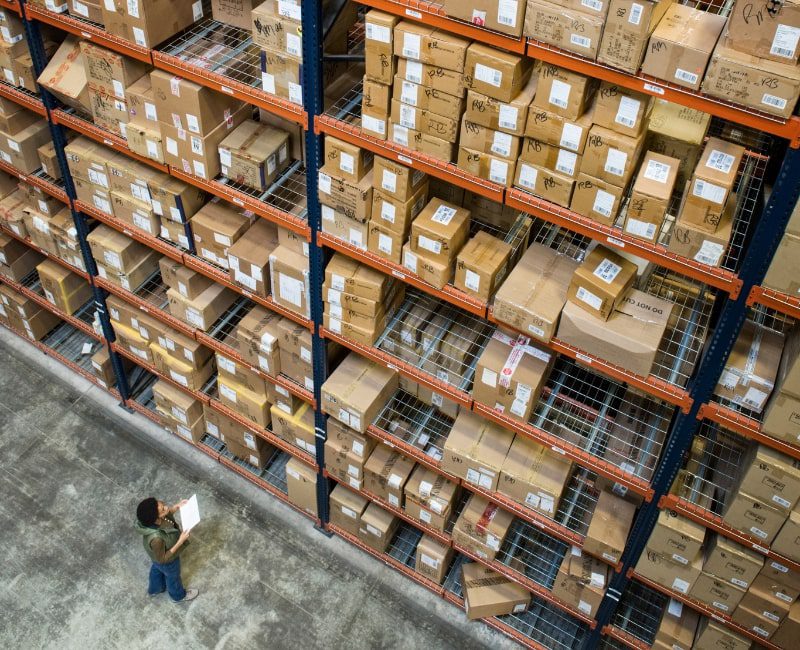Inventory management operations can be the difference between thriving profits and costly losses. Ineffective inventory management can set off a chain reaction, causing a surge in carrying costs, stockouts resulting in missed sales, and a growing list of dissatisfied customers. The financial implications of these issues can severely impact your business’s ability to grow and maximize profitability.
Inventory management should balance meeting customer demand and maintaining a healthy bottom line. That’s why we’re looking into five common inventory management mistakes that could be silently draining your resources and sharing actionable tips on avoiding these pitfalls and optimizing your inventory levels.
1. Overstocking Inventory
While having ample products on hand seems like a safe bet to avoid stockouts, overstocking can create a financial hole for your business. Excess inventory ties up valuable capital that could be invested elsewhere, like marketing or research and development.

The Hidden Costs of Overstocking
A surplus of unsold inventory results in significant markdowns and losses for your business. According to IHL Group, overstocks account for nearly 32% of retail inventory distortion, which is about $472.5 billion in lost sales.
Storage Costs: The more inventory you have, the more space you need. This translates to higher warehousing expenses, including rent, utilities, and labor.
Obsolescence Risk: Products can become outdated or spoil, especially in industries like technology or food. Overstocking increases the risk of your inventory losing value or becoming unsellable.
Tied-up Capital: Money invested in excess inventory is money you can’t use for other growth opportunities. It’s like having cash locked in a safe instead of earning interest in a bank.
Pro Tip: Identify Slow-Moving Items and Adjust Ordering Accordingly
To avoid this problem, regularly analyze your sales data to identify products with low turnover rates. Implement an inventory management system that tracks product velocity and provides insights into demand patterns. This will enable you to adjust your ordering quantities based on actual sales, minimizing the risk of overstocking.
2. Understocking Inventory
On the other hand, having too little inventory can be equally detrimental. Stockouts lead to missed sales opportunities and frustrated customers who may turn to your competitors to fulfill their needs.
The Lost Sales Opportunity
The inability to fulfill customer orders due to understocking creates a cascade of missed opportunities that can significantly impact your business’s bottom line.
Customer Dissatisfaction: When customers can’t find the products they want, they’re likely to leave empty-handed and disappointed. This negative experience can damage their perception of your brand.
Missed Revenue: Every stockout represents a lost sale and potential profit. The immediate financial impact is clear, but the long-term consequences can be even more significant.
The effect of understocking can extend far beyond immediate lost sales. Customers who experience frequent stockouts are less likely to return, impacting your customer loyalty and brand reputation. In the competitive eCommerce market, building and maintaining a positive brand image is crucial for sustained success.
Pro Tip: Implement Safety Stock Levels and Demand Forecasting Tools
Establishing safety stock levels acts as a buffer against unexpected spikes in demand or supplier delays. Additionally, leveraging demand forecasting tools can help you anticipate future sales trends, enabling you to maintain optimal inventory levels and minimize the risk of stockouts.
3. Inaccurate Inventory Tracking
Relying on manual processes or outdated inventory systems creates the perfect environment for errors and discrepancies. Miscounting, misplaced items, and data entry mistakes can lead to a significant mismatch between your recorded inventory and what’s actually on your shelves.

The Pitfalls of Inventory Inaccuracy
Inefficiencies caused by inaccurate inventory tracking can create a ripple effect throughout your supply chain, impacting your customer service, productivity, and ultimately, your profitability.
Order Fulfillment Errors: When your inventory records are inaccurate, you risk shipping the wrong products or quantities to customers, leading to returns, refunds, and damaged customer relationships.
Production Delays: Inaccurate inventory data can disrupt your production schedules. If you believe you have enough raw materials on hand but discover a shortage, it can halt production and lead to missed deadlines.
Pro Tip: Invest in Inventory Management Software and Conduct Regular Cycle Counts
Implementing a robust inventory management system can automate many of the manual processes that lead to errors. Regular cycle counts, where you physically verify a portion of your inventory, can help you identify and correct discrepancies before they become major problems. By prioritizing accurate inventory tracking, you can enhance your operational efficiency, improve customer satisfaction, and protect your bottom line.
4. Lack of Demand Forecasting
Failing to anticipate customer demand can leave your business constantly playing catch-up, leading to a reactive ordering cycle that struggles to keep pace with the market.
The Blind Spot of Reactive Ordering
A lack of demand forecasting creates a blind spot in your operations. You risk missing out on emerging trends or experiencing substantial stock imbalances.
Missed Trends: Consumer preferences and market trends can shift rapidly. Failing to anticipate these changes can result in missed sales opportunities and excess inventory of products that are no longer in demand.
Stock Imbalances: Without proper forecasting, you may end up with too much of one product and not enough of another. This can lead to stockouts of popular items and overstocks of slow-moving products.
Seasonality and market fluctuations can significantly impact inventory needs. A holiday rush or sudden change in consumer behavior can leave you scrambling to adjust your inventory levels if you haven’t planned ahead.
Pro Tip: Utilize Historical Sales Data and Consider External Factors for Forecasting
By proactively anticipating customer demand, you can optimize your inventory levels, reduce carrying costs, and avoid stockouts. Leverage historical sales data to identify patterns and trends in customer demand. Consider external factors such as economic conditions, competitor activity, and marketing campaigns when creating your forecasts.
5. Poor Supplier Relationships
Your suppliers are an integral part of your inventory ecosystem. A breakdown in communication or collaboration can create a weak link in your supply chain, opening your business up to costly disruptions that impact your inventory management and customer satisfaction.

The Weak Link in Your Supply Chain
Unreliable suppliers can lead to delayed shipments or inconsistent product quality, leaving you scrambling to fulfill orders and maintain customer trust.
Lead Time Delays: If your suppliers consistently miss delivery deadlines, it can disrupt your production schedules and lead to stockouts.
Quality Issues: Receiving defective or substandard products can lead to customer returns and additional costs associated with rework or disposal.
Maintaining open and transparent communication with your suppliers is essential for preventing these disruptions. Collaborative planning, quality assurance solutions, and regular updates can help you anticipate potential issues and adjust your inventory strategy accordingly.
Pro Tip: Negotiate Favorable Terms and Establish Open Lines of Communication
Negotiating clear terms regarding lead times, delivery schedules, and quality standards can help set expectations and minimize the risk of disruptions. Foster a collaborative relationship with your suppliers by establishing open lines of communication and providing regular feedback. By prioritizing strong supplier relationships, you can enhance your inventory management capabilities and ensure a smooth flow of goods throughout your supply chain.
Investing in Expert Inventory Management
Navigating the complexities of inventory management can be challenging, but you don’t have to go it alone. Partnering with a third-party logistics (3PL) provider can offer a strategic advantage in optimizing your inventory control and avoiding these costly mistakes.

Partnering for Success
Collaborating with a 3PL allows you to leverage their expertise, technology, and infrastructure to streamline your inventory operations. They can provide the support and resources needed to enhance your inventory management capabilities and drive efficiency throughout your supply chain.
Advanced Technology: 3PLs utilize sophisticated inventory management systems that provide real-time visibility into your stock levels, enabling you to make informed decisions and avoid overstocking or understocking.
Industry Expertise: 3PLs bring years of experience in inventory management best practices. Their knowledge can help you implement effective strategies to optimize your inventory levels and reduce costs.
Scalability: As your business grows, a 3PL can scale its services to meet your evolving needs, ensuring you have the flexibility to adapt to changing market demands.
3PLs expertly handle the logistical aspects of inventory management, including warehousing, order fulfillment, and transportation.
Pro Tip: Look for a 3PL Partner Who Offers Custom Solutions
Every business has unique inventory management requirements. Choose a 3PL that understands your specific needs and can tailor their services to align with your goals. By partnering with a 3PL, you can gain a competitive edge, enhance your customer satisfaction, and achieve sustainable growth.
Mastering Inventory Management for Lasting Success
By understanding and avoiding the five common mistakes we’ve outlined, you can take the necessary steps to transform your inventory management from a potential liability into a powerful asset. Optimized inventory levels translate to reduced carrying costs, improved cash flow, and increased profitability. Minimized stockouts ensure you meet customer demand, boosting sales and fostering loyalty. Efficient inventory control streamlines your operations, freeing up resources for growth and innovation.
Proactive inventory management is essential for maintaining a healthy bottom line and ensuring your company’s long-term success. By investing in expert inventory management and partnering with a 3PL provider like Hanzo Logistics, you can gain access to the tools, technology, and expertise needed to optimize your inventory control and achieve sustainable growth.
At Hanzo Logistics, we’re committed to helping you achieve excellence in inventory management. Ready to take control of your inventory and drive profitability? Explore our comprehensive inventory management solutions and discover how we can tailor our services to streamline your operations, reduce costs, and optimize your inventory levels.



